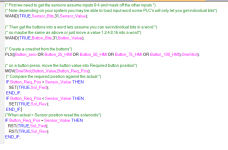I am looking for different solution on controlling a pneumatic Cylinder move at preset positions.
One of the solutions is to use 5 magnetic switches on the cylinder for close , 1/4 , 1/2, 3/4, 4/4 positions
I did write the code in structure text and it's working at list on codesys simulation.
Since I am fairly new to the PLC word I would like some feedback on what I have done.
If anybody is willing to have a look and comment i can share the code
One of the solutions is to use 5 magnetic switches on the cylinder for close , 1/4 , 1/2, 3/4, 4/4 positions
I did write the code in structure text and it's working at list on codesys simulation.
Since I am fairly new to the PLC word I would like some feedback on what I have done.
If anybody is willing to have a look and comment i can share the code






